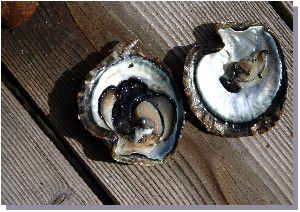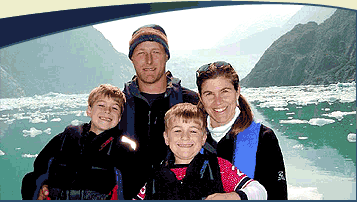Makemo Atoll
We took three days to cross from the Marquesas Islands to the Tuamotu Atolls. As per our usual track record, we advanced to the Makemo atoll in doozie of a squall. We encountered 50 knot sustained winds with gusts up to 70 knots. Running down wind with it was amazingly calm and comfortable. It passed just in time to let us enter our first atoll though through a washing machine sea. Once inside we anchored and began a wonderful week of snorkeling, meeting the locals and learning of the art of black pearl carving.
Instantly greeted by warm and friendly people, everyone waves as if you've always lived there. We did a bit of shell hunting, enjoyed the fare of the local hamburger/ ice cream hut at the dock. At nights the locals were having a bacci ball tournament, with kids running around and music playing everywhere. Some local children treated us to new hand games and a demonstration of the Haka (warrior dance).
Equipped with a beautiful bakery and plenty of well stocked magasin's we were in heaven. Highlights of the week were meeting Beco & Jaqueline Kamake. The black pearl farmer and the only one in Makemo let alone Marquesas that we know of. He did phenomenal work, intricate and ornate, in the blink of an eye. Never did he hesitate while his children ran around him or we gawked at a nose length away. We traded what we could with him for some pearls and carved tiki's made of bone. One of seven brothers, we were able to meet some of his family.
|
|
Victor is one of Beco's older brothers and an amazing fisherman. The first introduction was spying him with 10 Dorado in his boat as he was trying to give one away to the Kelly's. Bruce and a few others had the chance to go fish with him in his boat for a day and attempt to catch some for themselves. Local lesson, when the water is flat, no Dorado, but they did catch some Bonita. To see him in action I hear is a sight, while he drives his panga style fishing boat with what looks like the equivalent of a wooden joy stick up at the bow. He watches the air for birds, spots the fish in the water and spears them. He is also known to dive amazing depths, with or without sharks for the catch of the day. Beco say's he is crazy.
One delight was to attend their Sunday Church service for Mother's Day in Makemo. The vaulted ceiling bejeweled with chandeliers made of sea shells, echoed back their voices with such strength, beauty and pride. It was a treat to share with them.
Best of all we all got our feet wet with a wonderful week of snorkeling. The waters were so clear and calm allowing us all the opportunity to practice our free diving and spotting many different varieties of fish, coral and a small octopus. We quickly got used to the occasional black tipped shark who spied our activity from time to time.
Exiting Makemo we drove through the atoll with the company of Capaz and Moorea. It was our first real opportunity at spotting corals reefs and heads Tristan gladly climbed the mast to spot from up high. With everyone at their stations we all slowly picked our way for a couple of days until we made it to the next pass to exit. On one of our stops we all dinghied to shore and discovered large hermit crabs, which of course can only lead to hermit crab races.
|
|
|
Tahanea Atoll
An uninhabited island, low lying atoll, we were excited to explore the waters. The land itself only stands a few feet above water level and is only a hundred yards or so wide. With few trees and shrubs growing on the coral island you can see right across it. In the anchorage, our boats were frequently surrounded by black tip sharks curious at our vessels. I am sure the free food hand outs helped. Though no threat to us, their presence certainly slowed down our free swim time. They rarely showed up in the passes when we snorkeled and it was there that we discovered another beautiful under water world.
Each day we explored a different pass or coral patch and found an even greater variety of corals and fish then previously seen. The anchorage was nestled between various different passes which makes for swifter currents and water flow. We took to holding onto the dinghy, letting it drift and drag us along as we covered great ground and eyed the world around us.
|
We placed one of the boys cameras in a water proof bag and tried to get these wonderful creatures to pose for some photos.
|
|
Fakarava Atoll
One more time we made a day crossing between atolls and found ourselves in a squall. Not a big squall but enough to catch us at a busy moment when Bruce was trying to land his first Dorado. A whopper at that measuring 51". The fish was landed, the squall passed and we were a bit worn out with some torn sails and bruised prides and another pass to enter. The pass always looks different on paper than in person and takes a bit of luck and detective work to figure out just how to enter. We made our way through and anchored soon to be joined by some other boats. s/v Moorea's engine quite working properly after they entered the pass and showed us all how to really do it right. They sailed the rest of the way in at set anchor, smooth.
| |
|
We spent one night and day anchored off the Tetamanu Village next to Tumakohua Pass. There is a small dive shop and Pension (guest house) that you can rent for vacations there. We met some nice Australian families vacationing there. We also had our first encounter with a Napoleon fish. They are enormous colorful blue fish with big bumps on their forehead. This one in particular liked to hang out near the local restaurant to be fed. They must feed him well as he looked to be at least 4-5 feet long. |
We took a couple of days to pass through the atoll with the same spotters ahead and made our way to the north end of the island anchoring in the town of Rotoava. A lovely little town with some nice restaurants, and airport and pearl farms. We had a chance to borrow bikes from Moorea and took a ride around town. Can't remember the last time we were on bikes but it's true, it comes right back to you. |
We took a tour of a pearl farm and were able to see the tools used to reseed the oysters in order to grow pearls. A process that takes them 10 seconds to complete before damaging the oyster in order to grow cultured pearls over a couple of years time.
|

Pearl found in the center of the oyster |
The boys met another boy from Nelson Australia and together with the Capaz crew created recycle trash boats and had a race. We are quickly learning the lessons of wind and water currents effects on life. A little more provisioning and we prepared for a few days crossing to Tahiti. Time to go have our boats needs tended to. Sails to sew, alternators and regulators to repair. Best of all company from home coming!
|
|







